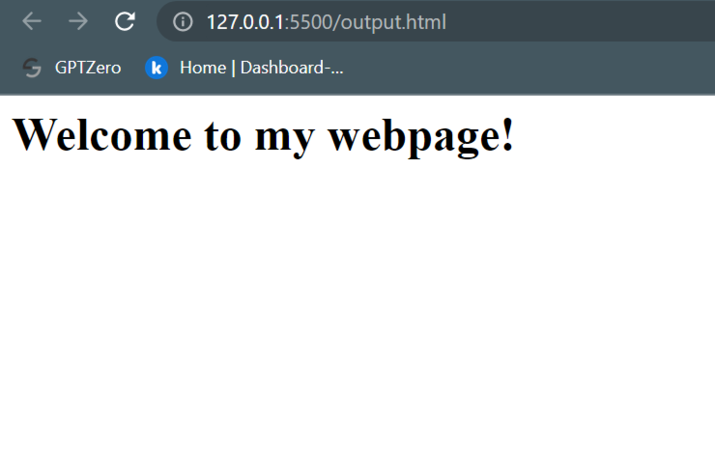
 Data Structure
Data Structure Networking
Networking RDBMS
RDBMS Operating System
Operating System Java
Java MS Excel
MS Excel iOS
iOS HTML
HTML CSS
CSS Android
Android Python
Python C Programming
C Programming C++
C++ C#
C# MongoDB
MongoDB MySQL
MySQL Javascript
Javascript PHP
PHP
- Selected Reading
- UPSC IAS Exams Notes
- Developer's Best Practices
- Questions and Answers
- Effective Resume Writing
- HR Interview Questions
- Computer Glossary
- Who is Who
How to write to an HTML file in Python?
HTML is a markup language that is used for creating web page structure and content in any web-related projects. Python provides various libraries and methods for writing to an HTML file. Python can be used to write to an HTML file using the open() function and write() method. In this article, we will explore how to write to an HTML file in Python, including the necessary syntax and examples.
Writing to an HTML file
To write to an HTML file we need to first open the HTML file and then add content to it in HTML syntax using tags. Once we have finished writing to the HTML file we will close the file and then we can open the HTML file to see the added content. The three basic steps to write to an HTML file are :
Opening the HTML file
Writing Content to the File
Closing the file
Step 1: Opening the file using the open() function
In this step, we will open the file in write mode using the open() function. The open() function takes the file path and the mode in which you want to open the file as parameters. To specify the mode we pass the mode as "w" or "wt".
Syntax
file = open(file_path, mode)
Here, the parameters used are described below:
file_path: The path to the file you want to open, including the file name and extension.
mode: The mode in which the file should be opened. Common modes include:
"r": Read mode (default), opens the file for reading.
"w": Write mode, opens the file for writing. Creates a new file if it doesn't exist or truncates the file if it exists.
"a": Append mode, opens the file for appending data. Creates a new file if it doesn't exist.
"x": Exclusive creation mode, opens the file for exclusive creation. Raises an error if the file already exists.
"t": Text mode (default), opens the file in text mode.
"b": Binary mode, opens the file in binary mode.
Code
In the below example, we open a file named "output.html" in write mode. If the file does not exist, Python will create it. If the file already exists, its previous content will be overwritten.
file = open("output.html", "w")
Step 2: Writing HTML content
If the file is opened using the open() method used in step-1 we can add write HTML content to the file using the write() function of the file object.
Syntax
file.write(content)
Here, the content is the data or content to be written to the file. It can be a string or any other data type that can be converted to a string.
Example
In the below example, we write a simple HTML structure to the file. Each write() call adds content to the file, which will be rendered as HTML when the file is opened in a web browser.
file.write("<html>")
file.write("<head>")
file.write("<title>My Webpage</title>")
file.write("</head>")
file.write("<body>")
file.write("<h1>Welcome to my webpage!</h1>")
file.write("</body>")
file.write("</html>")
Step 3: Closing the file
Once the content is written to the file we need to close the file using the close() method. When the file is closed all the changes are saved and the system resources are freed up. By closing the file, you complete the writing process and make the file available for other operations or for viewing.
Syntax
file.close()
Here, the close() function is called on the file object to close the file after reading or writing operations. It is good practice to close the file to ensure proper file handling and release system resources.
Example
In the foll;owing example, we create an HTML file named "output.html" and write a basic webpage structure to it. Finally, we close the file and display a success message.
# Open the file in write mode
file = open("output.html", "w")
# Write HTML content
file.write("<html>")
file.write("<head>")
file.write("<title>My Webpage</title>")
file.write("</head>")
file.write("<body>")
file.write("<h1>Welcome to my webpage!</h1>")
file.write("</body>")
file.write("</html>")
# Close the file
file.close()
print("HTML file successfully written.")
Output
HTML file successfully written.
On running the HTML file output.html the webpage looks like :

Conclusion
In this article, we discussed how we can write content to an HTML file using Python. By using the open() function to create a file object, the write() method to add HTML content, and the close() method to finalize the writing process, you can easily generate dynamic HTML files in Python. We discussed the step-by-step process of writing to an HTML file in Python. We covered the necessary syntax and provided an example to illustrate the process. By following these guidelines, you can create HTML files programmatically, allowing you to generate dynamic content for your web projects.

